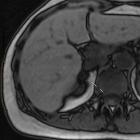Conn-Syndrom









Conn syndrome, also known as primary hyperaldosteronism, is a condition of excess of aldosterone production and occurs secondary to adrenal cortical adenoma, bilateral adrenal hyperplasia, or rarely, adrenal carcinoma. Differentiation between the causes is required to avoid unnecessary surgery.
Clinical presentation
Conn syndrome typically presents with diastolic hypertension, metabolic alkalosis, and hypokalemia. Other symptoms include muscular weakness, paresthesias, headache, polyuria, and polydipsia. Edema is rare in these patients.
Pathology
Primary hyperaldosteronism is distinguished from secondary hyperaldosteronism by measurement of serum renin:
- primary: low renin levels
- secondary: high renin levels
Etiology
Conn syndrome is due to an autonomous solitary adrenal cortical adenoma in 65-70% of cases, with the remainder almost entirely due to bilateral adrenal hyperplasia (25-30%) with adrenal carcinoma being a rare cause.
Excess secretion of aldosterone can also occur in renin-related hypertension.
Markers
The aldosterone level tends to increase and the aldosterone-to-renin ratio is also increased.
The biochemical analysis may also demonstrate hypokalemia, which may be the first clue to the diagnosis of aldosteronoma in a patient being evaluated for hypertension. The baseline plasma aldosterone is usually greater than 20 g/dL.
Radiographic features
Adrenal adenomas in Conn syndrome tend to be unilateral (95%) quite small, often ~2 cm (range 1-5 cm) in diameter, and can be a challenge to detect, even by CT or MR imaging.
Selective adrenal arteriography, venous sampling, adrenal phlebography, radionuclide studies and CT scans are helpful in diagnosis.
CT
- aldosteronomas are homogeneous and often hypodense, with an attenuation value near that of water (<10 HU)
- none or minimal contrast enhancement
- rarely calcify
- detects 70% of aldosteronomas, although small lesions may be missed
- if CT findings are negative, selective adrenal venous sampling for aldosterone or a dexamethasone suppressed iodocholesterol adrenal scan may identify the lesion
Angiography
Adrenal venous sampling to assay aldosterone serum via selective catheterization of both adrenal veins, may still only be helpful in ~50% of cases.
Treatment and prognosis
If a solitary adrenal mass is detected, surgical adrenalectomy will correct hypertension in 75-90% of cases. Bilateral adrenalectomy in patients with hyperplasia is not usually an effective treatment and results in adrenal insufficiency and is usually treated medically, making the differentiation between the etiologies necessary, to avoid unnecessary surgery.
History and etymology
It is named after Jerome W Conn (1907-1994), an American endocrinologist, who described the condition in 1955 . Although it was a Polish physician, Michał Lityński (1906-1989), who first described a case in 1953 . This is one of many examples of Stigler's law of eponymy, that an eponym is never named after the original discover of a condition .
See also
Siehe auch:
und weiter:

 Assoziationen und Differentialdiagnosen zu Conn-Syndrom:
Assoziationen und Differentialdiagnosen zu Conn-Syndrom:

